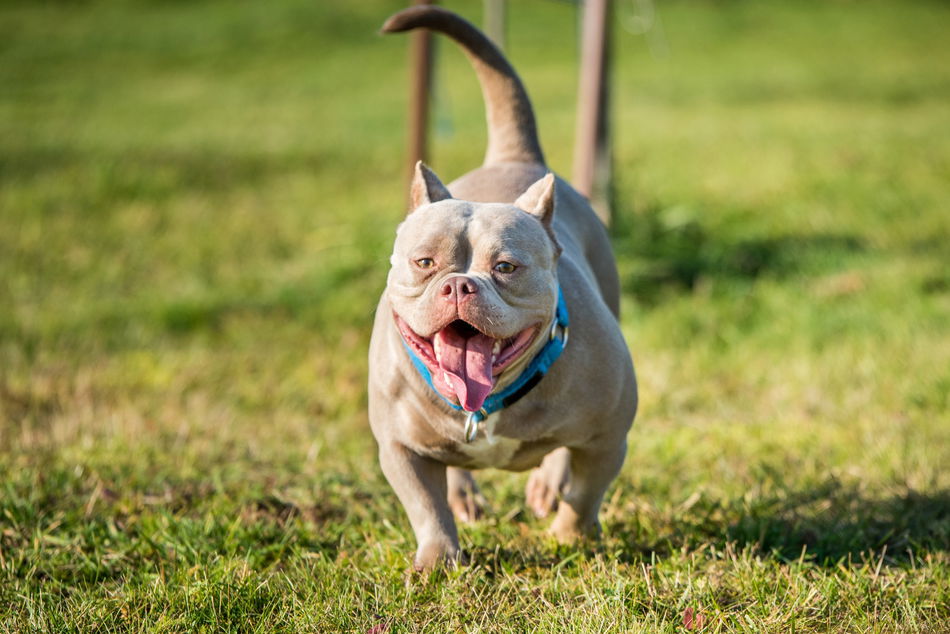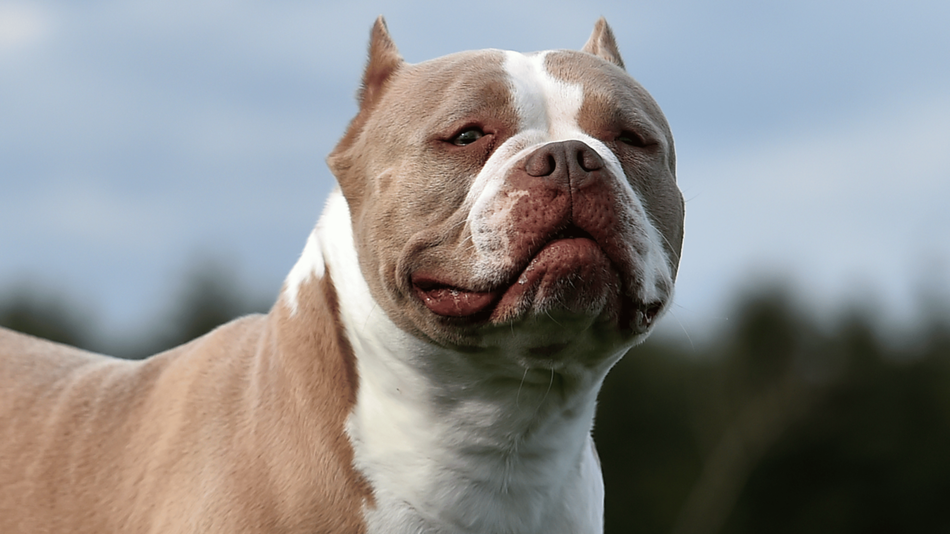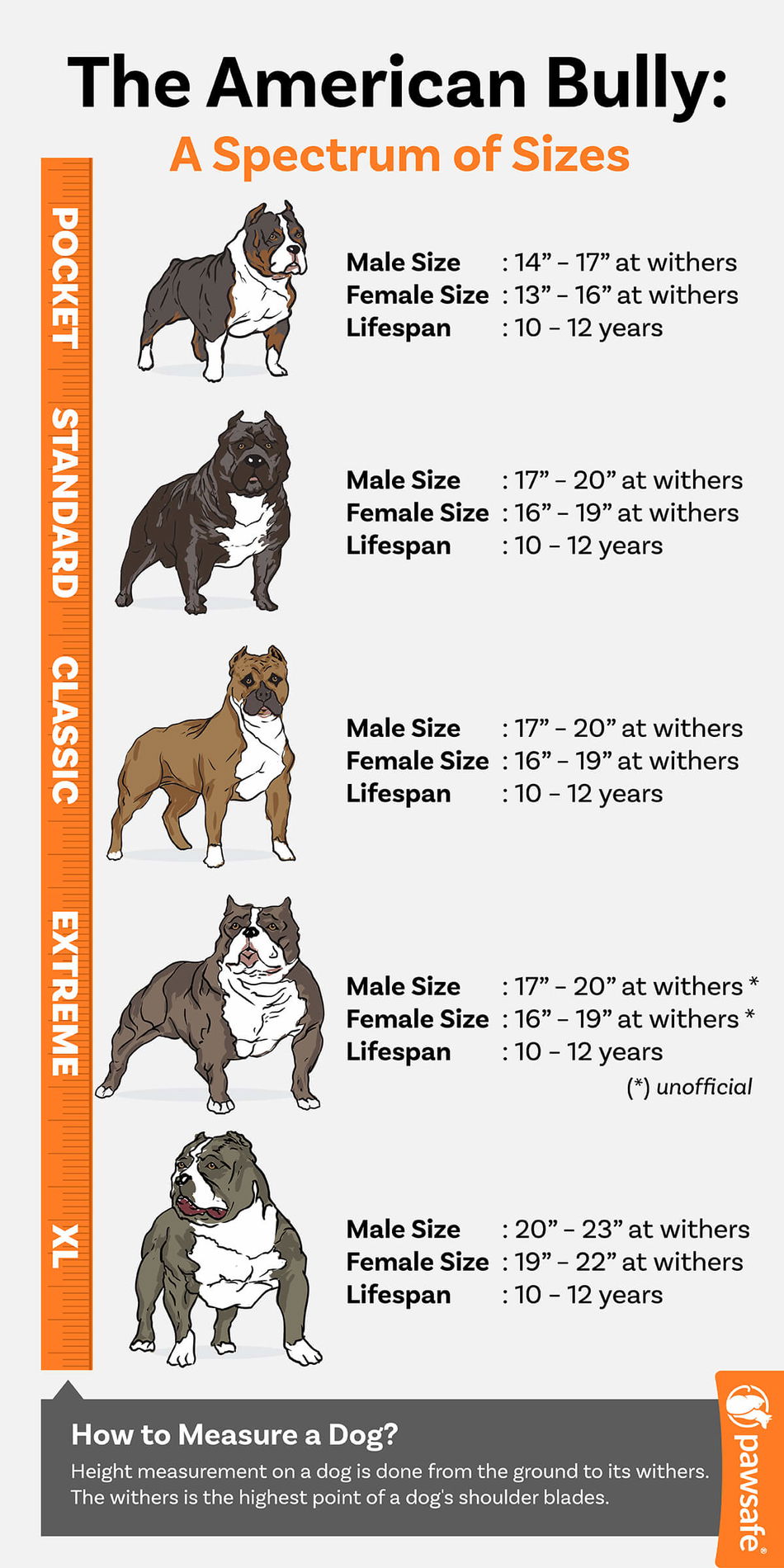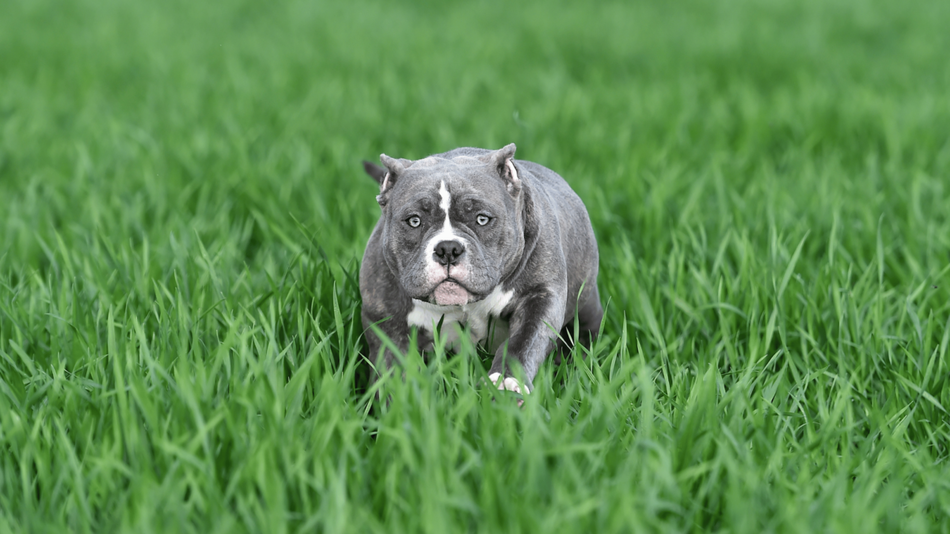
The pocket bully is a smaller version of the muscular standard American Bully. This dog, though tiny, still looks like a cute house hippo, and their small sizes make them manageable for most owners. They’re one of the four official American Bully types: Pocket, standard, classic, and XL.
As the American Bully is still an emerging breed, there is a lot of confusion over the various types, and many dogs are emerging that are not officially recognized by the American Bully Kennel Club (ABKC). So we will focus on American Pocket Bully as outlined by the ABKC. Keep in mind, these dogs can have joint issues as they age, so it’s best to give them daily dog mobility chews.
The Pocket Bully is as goofy and sweet as their larger counterparts but in an adorable compact package. But before looking for American Pocket Bully Puppies for sale, it’s essential to research this emerging breed. So to give you the best lowdown on the Pocket American Bully, we consulted interviews with American Pocket Bully breeder, expert, and founder, Dave Wilson.
So, What is a Pocket Bully?
The Pocket Bully is the smallest recognized version of the American Bully dog, an emerging Pit bull-type breed. They are incredibly stocky, muscular dogs that combine the bulk of Bulldogs with the presence of a Pit bull. These are cheerful, outgoing dogs that make great companions, but may be prone to several health issues due to their exaggerated features.
History of the Pocket Bully

Pocket Bullies share their history as the larger American Bullies. Even though normal-sized American Bullies are purebred dogs, they’re not formally recognized by most dog clubs, such as the AKC. However, they do have their own registries, such as the ABKC. This is a very modern breed, developed in the 1980s and fine-tuned in the nineties with kennels like Razor Edge.
American Bullies mostly come from a mix of American Pit bull Terrier (APBT) and American Staffordshire Terrier that have been bred for a calmer temperament than the APBT. A particular APBT strain produced stocky physiques and was later bred with American Bulldogs, and English Bulldogs to create bigger heads, shorter legs, and broad barrel-like chests.
They may also have influence from smaller breeds like the Patterdale Terrier, however, this is unlikely to be true since the Patterdale Terrier is simply to small to give the Bully the bulky features breeders aim for in an American Pocket Bully puppy.
The American Bully breed has five categories based on height and weight. These include the Pocket, classic, standard, extreme, and Xl bullies.

The American Bully Kennel Club (ABKC) acknowledged all the Bully varieties in 2004. Gaining recognition from better-known clubs like the American Kennel Club (AKC) may be in this breed’s near future, but they’re still a developing breed with some way to go. One of the issues they face is dogs being bred to too extreme proportions. Another problem is the number of breeders marketing new types of Bully breeds or labeling crossbreeds as American Bully.
To be clear, there is a lot of debate and controversy over the Bully breeds, acceptable types, their future, and breeding for exaggerated features that could lead to health issues. The aim of the Pocket Bully is not to be like other “teacup” dog breeds. But instead, to balance the maximum amount of strength and power in a relatively small frame. So this raises the question of how the Pocket Bully differs from other small Bully type dogs.
Exotic Bully vs. Pocket Bully
With so many emerging American Bully varieties, controversy and confusion abound. One point of debate is the new Exotic Bully or Clean Exotic. The Exotic Bully has more extreme proportions than the Pocket Bully. It also seems to be crossed with other breeds, namely:
- American Bully;
- French Bulldog;
- English Bulldog;
- Old English Bulldog; and
- Shorty Bull.
Unlike the Pocket Bully, the Exotic Bully is not recognized by the ABKC. Instead, it has its own registry, The IBC or International Bully Coalition.
Exotic Bullies can be any color except albino. In general, they are shorter dogs than the Pocket Bully, looking more like a French Bulldog Pitbull mix that has been doing some pretty intense weight lifting. In other words, the Exotic Bully has more exaggerated features on a more petite and more compact frame than the American Pocket Bully.
But the breed standard allows for Exotic Bullies to be:
- Males: no bigger than 42 cm (16.5 inches) and 37 kg (81 lbs)
- Females: no bigger than 40 cm (15 inches) and 32 kg (70 lbs)
There are many different names for the Exotic Bully, including:
- American Bully Exotic Pocket,
- American Bully Pocket Exotic,
- American Bully Dog Exotic,
- and Exotic American Bulldog
Below is a video with an Exotic Bully:
Help Dogs In Need
Our blog posts aim to provide comprehensive, accurate, and objective information on all types of dogs, helping our readers make informed choices that fit their lifestyle.
We don't endorse any specific breeding practices, but advocate for ethical breeding and dog welfare. We encourage exploring adoption first. Countless wonderful dogs, from all breeds, await their forever homes in shelters. Remember, with #AdoptDontShop, you can give a deserving rescue a second chance at happiness.
Micro Bully vs. Pocket Bully
To make things even more confusing, another small Bully type has emerged, often mistaken or mislabeled as a ‘Micro Pocket Bully’. The micro Bully is smaller than the Pocket Bully and even smaller than the Exotic.
The Micro Bully stands at a mere 10 inches (25 cm). In contrast, the Pocket Bullies are bigger at 14 to 17 inches. Below is a video showing a Micro Bully where you can see how extreme their proportions are compared to other small dogs.
What Does A Pocket Bully Look Like?

Pocket Bullies are short, compact dogs with firm bodies and are incredibly muscular for their small size. They have a thick, wide head characteristic of bullies, broad chests, and short, stocky legs. The muscular build gives these small dogs a powerful look, and their naturally floppy ears can be cropped or left alone.
How Much Does the American Pocket Bully Weigh?
The American Pocket Bully is a compact, muscular dog and typically weighs between 30 to 50 pounds (14 to 23 kilograms). This breed is characterized by its substantial bone structure and bulk, which is packed into a relatively small body, emphasizing its unique and distinctive appearance.
How Tall Does the American Pocket Bully Stand?
Regarding height, the American Pocket Bully stands at around 12 to 16 inches (30 to 41 centimeters) at the shoulder. Despite their shorter stature, they exhibit strength, agility, and vigor, portraying a solid and robust physique.
Coat Type and Colors of the Pocket Bully (and Eye Colors)
The coat of the American Pocket Bully is short, glossy, and smooth to the touch. They shed moderately all year and are not hypoallergenic. This breed displays a wide variety of colors, including but not limited to, fawn, black, brown, and brindle. Patterns and markings can also be diverse, contributing to each individual dog’s uniqueness.
Colors:
- Fawn;
- Black;
- Blue;
- Chocolate/Brown;
- Lilac;
- White;
- Brindle;
- Sable;
- Red;
- Tri-color (combination of any three colors); and
- Merle (mottled patches of color).
Patterns:
- Solid;
- Brindle;
- Piebald (irregular patches of two colors);
- Ticking (small, isolated areas of black or colored hairs on a white background);
- Pinto (large, irregular patches of color); and
- Mask (color, usually black or dark, covering the muzzle/face).
Eye color in the American Pocket Bully can range significantly, with shades of brown being most common, but blue, green, and amber are also possible. The diversity in eye color, coupled with their distinctive coat patterns and colors, makes each American Pocket Bully uniquely attractive.
They also have blue-nose and red-nose varieties.
However, many Merle Pitbulls are sometimes the result of questionable breeding practices and are prone to health issues because of the genetic mutation, as outlined by UC Davis University. So the Merle pocket bullies are not recognized by the American Bully Kennel Club. It is also vital to be careful of any Pocket Bully breeders who breed for rare colors, because lilac American bully puppies (or merle and tricolor puppies) can fetch higher prices, but this is often at the cost of the dog’s genetic health.
What Is An Extreme Pocket Bully?
The Extreme Pocket Bully is a variation of the American Bully, characterized by its compact size and substantial body mass for its stature. Despite being smaller, this breed showcases exaggerated features, including a broader head, denser bone structure, and more pronounced muscular development compared to other pocket bully varieties.
Characteristics of the Extreme Pocket Bully:
The Extreme Pocket Bully maintains the short height of the pocket bully, not exceeding 17 inches (43 cm) at the withers, but displays enhanced muscularity, a wider frame, and heavier bone density. They exhibit a distinct, powerful appearance while retaining the trademark temperament of loyalty, confidence, and a zest for life that is prevalent in the American Bully breeds.
General Care of the Pocket Bully

Energy
The Pocket Bully is a moderate-energy dog. They are far from being couch potatoes like their English and French Bulldog cousins as they have the more athletic American Pitbull background. But their sheer bulk makes too much exercise impossible due to stress on their joints and being prone to heatstroke.
Exercise needs
Pocket Bullies do best with two 20 to 30-minute walks every day to stay mentally and physically fit. They can also participate in sports like weight pulling and spring poles because of their athleticism and muscle mass. These dogs are, however, not built for endurance, so keep every exercise session short and sweet.
These dogs also need a fair share of mental workouts, from obediences and food puzzles. Mental and physical stimulation work together to create a well-natured and happy doggo and should never be neglected.
Housing needs
Pocket Bullies must be around their humans and do well in apartments and small spaces. They need to be indoors as they are vulnerable to both cold and heat. A home with a yard is a bonus because they can run around, but their small sizes make them unsuitable for outdoor living.
Food & Diet Requirements
Pocket Bullies have a relatively high muscle mass that needs plenty of protein (at least 30%) to be maintained. It may be quite challenging to tell when a Pocket Bully is overweight due to their characteristic wide and stocky physique.
Lean meat with plenty of omega-3 fatty acids is essential for these dogs, particularly as they are prone to thyroid problems. Look for poultry and fish-based diets with high levels of fish oil. They also need mixed soluble and insoluble fiber, with probiotics, for a healthy gut.
Grooming needs
These Bullies are easy to groom due to their short, single coats. All you need for grooming is quality shampoo, a pin brush or rubber glove, a pair of dog nail clippers, dog toothpaste, etc. Brushing the coat and teeth at least twice weekly keeps these parts clean and healthy.
Although most Pocket Bullies don’t have too many wrinkles, the few they have should be cleaned frequently. This prevents infections like skin folds pyoderma from accumulating moisture and dirt in the wrinkles. Remember monthly nail trims and regular ear cleaning.
Health Concerns of a Pocket Bully

Pocket Bullies are robust dogs but are not free from certain health conditions like musculoskeletal disorders like hip dysplasia and heart problems. Other health problems associated with the Pocket Bully include:
Severe Health Issues:
- Hip Dysplasia: A malformation of the hip joint causing pain and arthritis.
- Elbow Dysplasia: Similar to hip dysplasia but affects the front limbs.
- Congenital Heart Problems: Including subaortic and pulmonic stenosis, septal defect, and mitral valve disease.
- Hypothyroidism: An underactive thyroid gland leading to various symptoms including lethargy and weight gain.
- Eye Issues: Including entropion, a condition where the eyelid rolls inward, and glaucoma, leading to high intraocular pressure, pain, and potential loss of vision.
- Brachycephalic Airway Syndrome: Affecting dogs with shortened skulls and muzzles, leading to respiratory distress. According to research, Pocket bullies have the skull shape that makes them vulnerable to this.
- Cancers: Different types, including mast cell tumors and melanoma.
Moderate Health Issues:
- Skin Allergies: Can lead to itchiness, discomfort, and secondary infections.
- Dental Issues: Including periodontal disease, tooth loss, and other oral conditions.
- Skin Diseases: Conditions like eczema, seborrhea, and hot spots can affect their skin. Light colored dogs like blue can also have color dilution alopecia.
- Obesity: Leads to various health risks including diabetes and joint issues.
Occasional Health Issues:
- Bloat: A life-threatening condition due to the twisting of the stomach, more common in breeds with deep chests.
Conclusion
Regular veterinary checkups, a balanced diet, regular exercise, and prompt attention to emerging health concerns can mitigate the impact of these health issues and contribute to the well-being and longevity of the American Pocket Bully.
Temperament and Trainability of the Pocket Bully

Pocket Bullies are sweet, incredibly affectionate, loyal, good-natured, and gentle yet assertive. These dogs could cuddle with their family all day, every day, given the chance. They’re pretty gentle with strangers while maintaining alert protectiveness of their loved ones.
Pocket Bullies may not suffer discrimination their larger siblings and others like Pitbulls do. Some cities and apartments blatantly refuse entry for these gentle pups. However, the small size of the Pocket Bully excuses them from such stereotypes, even though they’re still quite muscular.
Though typical of the breed, all these positive attributes are not automatic. You can still end up with an ill-mannered dog if you don’t train and socialize them early enough. Some people may neglect training a Pocket Bully just because they’re small, but few things are worse than this ignorance.
Pocket Bullies are intelligent pups, so training them should be a breeze with the right treats and praise. They are also highly driven to please their owners, so obeying your commands is high on their to-do lists. Training is not an emphasized suggestion but a necessity for a well-adjusted dog.
Is the Pocket American Bully Dog Dangerous?
The Pocket American Bully has garnered a reputation, in some circles, as being dangerous due to its muscular build and strong appearance, but this characterization is generally unfounded. Like all dog breeds, the behavior of the Pocket American Bully is predominantly influenced by upbringing, training, socialization, and treatment.
Temperament:
The breed is known for its loyalty, intelligence, and affectionate nature, especially towards its human family. They are often good with children and can be protective, making them excellent family pets. Proper socialization from a young age is critical in promoting balanced and friendly behavior towards other animals and strangers. They tend to have more Bulldog-type dogs in their lineage, which gives the Pocket Bully a more laid back and easy-going temperament than bigger or more athletic Pitbulls and Bully breeds.
Training and Socialization:
Training should focus on positive reinforcement techniques, promoting desirable behaviors, and discouraging unwanted ones. Early, consistent socialization can help in reducing any potential aggression or fear-based reactions to unfamiliar stimuli, making them well-rounded and adaptable pets.
Breed Misconceptions:
The negative stereotypes surrounding the breed mainly stem from misconceptions and a lack of knowledge about the breed’s true nature. Responsible ownership, including proper training, socialization, and care, is pivotal in dispelling these myths and showcasing the breed’s true, loving nature.
Sociability with Children and Other Pets
Most Pocket Bullies and all Bully varieties are social butterflies; they get along with everyone, everything, every time! Their gentle and stable natures make them great family dogs that do well with kids. Regardless of their child tolerance, Pocket Bullies should never be left with small kinds to prevent either from getting hurt.
Even though Bullies were bred from fighting dogs like APBTs, they display friendliness to animals and other dogs. This isn’t true for all Pocket Bullies, where some can attempt to go up against much bigger dogs, placing themselves in harm’s way.
Only proper training and socialization stack the cards in your favor for a pup that does well with children and animals alike.
How Much Is A Pocket American Bully Worth?
Prices can vary widely depending on the breeder, the dog’s pedigree, health, and other factors. However, I can provide a generalized example based on typical considerations like color and breed subtype. Please consider consulting breeders or pet marketplaces for the most current and accurate pricing information.
| Type | Color | Estimated Price Range ($) |
|---|---|---|
| Extreme Pocket Bully | Merle | 2000 – 7000 |
| Extreme Pocket Bully | Tri-color | 2500 – 7500 |
| Extreme Pocket Bully | Blue | 2000 – 7000 |
| Extreme Pocket Bully | Lilac | 2500 – 8000 |
| Extreme Pocket Bully | Isabella | 3000 – 8500 |
| Normal Pocket Bully | Merle | 1500 – 6000 |
| Normal Pocket Bully | Tri-color | 1800 – 6500 |
| Normal Pocket Bully | Blue | 1500 – 6000 |
| Normal Pocket Bully | Lilac | 1800 – 7000 |
| Normal Pocket Bully | Isabella | 2000 – 7500 |
| Normal/Extreme | Others | 1000 – 5000 |
Note:
- Prices are highly variable and dependent on factors such as lineage, breeder reputation, location, and demand.
- Merle, tri-color, and other unique colorations often command higher prices due to their rarity and demand in the market.
- Always consider adopting from reputable breeders who prioritize the health and well-being of the animals over color or appearance.
- It’s also worth considering adoption from shelters or rescue organizations, where many wonderful pets, including bullies, are looking for loving homes.
Ideal Home for a Pocket Bully
- An owner wanting a companion dog and one that can spend plenty of time with them
- Apartment life as long as their energy requirements are met
- People who want low-shedding dogs
- Moderately active households
- Bully fanciers who love small dogs
- Can do well in a home with pets and children (with proper supervision and socialization)
Adopt an American Pocket Bully Dog
Choosing to adopt an American Pocket Bully can be a rewarding experience, providing a loving home to a dog in need and enriching your life with a loyal and affectionate companion. Adoption is a responsible and humane option, with numerous organizations specializing in rescue and rehoming services for bully breeds.
Here are a few reputable rescue organizations where you can adopt an American Pocket Bully:
- New York Bully Crew
- This organization is dedicated to the rescue and rehabilitation of abused and abandoned dogs, focusing primarily on bully breeds. They offer adoption services to place rescued dogs in loving, permanent homes.
- Lucci’s House Bully Rescue
- Lucci’s House is committed to the well-being and protection of bully breeds. They provide rescue, rehabilitation, and rehoming services, ensuring each dog finds a suitable and caring home.
- California Bully Rescue
- Specializing in the rescue of bully breeds in California, this organization is devoted to finding secure and loving homes for abandoned or mistreated dogs.
Things to Consider:
Before deciding to adopt, consider your lifestyle, household environment, and the time you can commit to training, socializing, and caring for a dog. Research the breed’s characteristics, needs, and common health issues to ensure you are well-prepared to provide a loving and suitable home for an American Pocket Bully.
How to Breed a Pocket Bully

Breeding the American Pocket Bully involves careful consideration of genetics, health, temperament, and conformation to breed standards. Here’s a simplified overview of the process:
Study the Breed Standard:
Familiarize yourself with the American Pocket Bully breed standard to understand the desirable traits and characteristics, ensuring you select suitable breeding pairs.
Select Healthy Parents:
Choose healthy male and female dogs that are free from hereditary diseases and conditions. Health clearances from veterinarians are crucial.
Genetic Testing:
Conduct genetic testing to identify and avoid passing on genetic disorders and to ensure the compatibility of breeding pairs.
Evaluate Temperament:
Choose dogs with stable, balanced temperaments. Avoid aggressive or overly timid individuals.
Proper Mating:
Arrange a controlled and comfortable environment for mating, and consider veterinary assistance if needed.
Prenatal Care:
Provide proper nutrition, veterinary care, and a safe, comfortable environment for the pregnant female.
Postnatal Care:
Ensure the puppies are healthy, receive proper nutrition, vaccinations, and are socialized from an early age.
Note:
Ethical breeding practices are crucial. Overbreeding and breeding solely for profit without regard to health and welfare are highly discouraged. Consult with experienced breeders and veterinary professionals throughout the process.
How to Train a Pocket Bully
Training a Pocket Bully requires consistency, patience, and positive reinforcement. Here are some steps to follow:
1. Start Early:
Begin training and socialization as early as possible, ideally when the dog is still a puppy.
2. Be Consistent:
Maintain consistency in commands, rewards, and consequences to avoid confusing the dog.
3. Use Positive Reinforcement:
Reward desired behaviors with treats, praise, or play. Avoid punishment-based methods as they can be counterproductive.
4. Set Clear Boundaries:
Establish and enforce rules consistently to help your dog understand what is expected.
5. Socialize:
Expose your dog to various environments, people, and other animals to promote adaptability and reduce fear and aggression.
6. Train Basic Commands:
Teach essential commands like sit, stay, come, and heel to ensure your dog can follow basic instructions and behave well.
7. Address Behavioral Issues:
Address any behavioral problems immediately, and consult a professional trainer or a vet if needed.
Conclusion:
Training a Pocket Bully takes time and effort but is essential for a harmonious household and a well-behaved pet. Positive, consistent, and early training sets the foundation for a lifetime of good behavior.
Frequently Asked Questions (FAQs)
Can Pocket Bullies breed naturally?
Many Pocket Bullies can breed naturally, but those with extreme proportions may struggle to mate without help. This is one reason that many Pocket Bully Breeders prefer to use surgical or artificial insemination.
Also, because of their short noses and huge heads, many breeders opt for a cesarean section rather than have their dogs give birth naturally. They usually have between 2 and 5 puppies.
What Long Does A Pocket Bully live?
Pocket Bullies can live between 12 to 15 years. This impressive lifespan can be credited to the hardiness of the parent breeds used in Bully formation, such as the APBT. Genetic makeup is the strongest determiner of life length, where dogs without predisposed conditions live longer.
How much is a Pocket Bully worth?
Prices for Pocket Bullies start at about $2000. However, Pocket Bullies from special bloodlines or with special colors like tricolor, Champagne (Lilac), blue fawns, or blue-nose Pocket Bullies can fetch eye-watering prices of up to $10 000. It’s known for special puppy prices to go even higher.
Final Thoughts
Pocket Bullies are small, compact designer dogs with the signature Bully thick head. They maintain a stocky and muscular physique but in an adorable tiny package. These dogs thrive on affection and attention and will make excellent additions to your family if you’ve established they’re right for you.
Meet Your Experts

Author
Tamsin de la Harpe has nearly two decades of experience with dogs in rescue, training, and behavior modification with fearful and aggressive dogs. She has worked closely with veterinarians and various kennels, building up extensive medical knowledge and an understanding of canine health and physiology. She also spent two years in the animal sciences as a canine nutrition researcher, focusing on longevity and holistic healthcare for our four-legged companions. Tamsin currently keeps a busy homestead with an assortment of rescue dogs and three Bullmastiffs.


